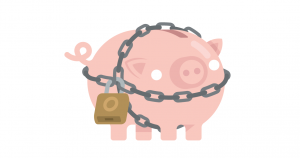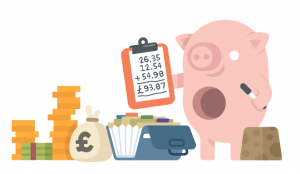These next two sections ‘Things to Consider’ and ‘The Total Cost of Borrowing‘ cover important points to think about before you borrow, including what factors determine the cost, and how different borrowing choices might affect the regular payments you need to make and the total amount you have to repay.
Do You Really Need to Borrow?

If you don’t absolutely have to spend the money immediately, do consider whether it’s worth waiting a bit and saving up for your purchase, rather than taking on debt.
If you do need to borrow, read on….
How Much Can You Afford?

This should be the starting point to determine how much you could borrow and what kind of product would be most appropriate.
There are two aspects to consider:
- You need to cover the monthly repayments
- You must be able to afford the total cost of repaying a debt
Financial jargon can be confusing, especially if you simply want to know how much a debt would cost per month. But don’t just select a product with the lowest monthly repayments – it might actually cost you more in the long run!
It’s important to understand the overall cost of borrowing and what factors affect it, so you can feel confident about choosing an affordable option that suits your needs and financial situation.
Total Cost of a Debt = Amount Borrowed + Interest Payments + Any Additional Charges & Fees
Find out more:
- What factors affect interest payments?
- The borrowing term
- Standardised APR (Annual Percentage Rate) for comparing borrowing options
- Potential charges & fees
- Manage monthly repayments
As a general rule…borrow as little as possible for as short a time as possible
Certainty v Flexibility
Some types of borrowing enable you to budget for regular fixed repayments over a defined time period, whilst others offer less predictability but more flexibility. Think about the alternatives, in terms of what suits your own financial situation and the impact on cost.
Regular repayments or lump sum
If you have an unpredictable or irregular income, you might prefer to pay back a lump sum as and when you can. But bear in mind that the longer a debt remains unpaid, the longer it accumulates interest costs.
You would pay less interest with regular payments, which gradually reduce your debt. And more frequent repayments reduce the debt faster, so you pay interest for a shorter time and therefore a lower amount overall.
- Loans are usually repaid in regular installments – a fixed amount each month, for an agreed term; (there may be a a penalty charge for early repayment)
- Credit/Overdrafts are generally more flexible with low or no minimum repayments (but tend to charge higher interest rates)
Fixed term or early settlement option
Do you want the option to clear your debt early if you do have spare cash? If so, look for flexible borrowing without penalties for early settlement.

Loans and mortgages are usually repaid over a fixed term; some apply a lock-in clause, which prohibits the borrower from prepaying before an agreed time; you would be charged a penalty for early settlement.
(The advantage to lenders is they know they will receive a definite minimum amount of interest payments during the lock-in period.) Early redemption/early repayment charges may be equivalent to about 1-2 months’ interest, which could add a considerable cost to the debt.
Fixed or variable interest rates
Be clear whether the interest rate is fixed or variable because this will affect costs.

Fixed
- A fixed rate remains unchanged for the term of the debt.
- Repayments are fixed installments (a set amount on a regular basis), therefore predictable and easy to budget. For this reason it is usually the preferred option for high value longer-term borrowing e.g. car, property, business etc.
Most personal loans have fixed rates, but do check.
- But fixed rates tend to be higher than variable – lenders charge more because they cannot adjust the rate.

Variable
- A variable rate fluctuates up and down in line with the Bank of England base rate or competitive market forces. Lenders can alter the rate at any time, after giving notice.
- Any change in interest rate will cause a corresponding rise or fall in monthly repayments and the overall cost of the debt.
- Most credit and overdrafts have variable rates.
It is impossible to predict how interest rates will behave years ahead; whilst lower variable rates might seem tempting, do consider whether you could afford higher repayments if interest rates rise, or whether fixed rate borrowing might be a safer option. Or investigate deals that offer a fixed rate for the first few years, before transferring to a variable rate.
Introductory Deals
You might be offered special introductory interest rates to tempt you into a deal.
Be aware they are likely to increase in time, so always find out what you are likely to be charged in the longer term.
Check the APR (Annual Percentage Rate) to see how the rate looks over the whole year – APR will take account of the introductory rate and the higher rate once the deal ends.
Some credit cards and overdrafts offer interest free deals up to an agreed amount or for a limited time
(e.g. Graduate Bank Accounts often include an initial interest free overdraft).
But be careful – ‘interest free’ applies only within the agreed limits; if you exceed the amount or fail to pay back in time, you will face high interest rates and charges, as well as damaging your credit rating!
Secured v Unsecured Loans
With a secured loan, a lender requires some security against the money you borrow e.g. your car or house. It means that if you fail to pay it back, the lender can sell that asset to clear your debt.
Unsecured loans e.g. personal loans, are not secured against an asset so they pose less risk to the borrower, though you could be taken to court if you default on repayments.
Interest rates tend to be higher for unsecured loans, because they pose a bigger risk for the lender.
Credit Rating – Build a Credit History
Your credit rating and financial history indicates what sort of risk you represent to lenders, and therefore determines whether they will let you borrow money and what sort of deal you will be offered – so it’s a good idea to start building up a credit history. 
You can begin simply by establishing a good track record managing your accounts (e.g. mobile phone contract, rent, utilities, and bank accounts).
Find out more:
Before You Commit to any Borrowing…
Carefully consider the overall cost, including interest rate (APR) and any fees and charges.
Be clear about how and when you will have enough money to pay back the debt (including monthly repayments if applicable).
Make sure you understand exactly what you are signing up for.
Always get independent, professional advice for your particular situation.

